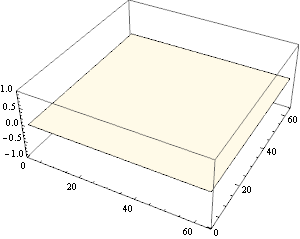I want to adjust some code that I found on this Wolfram Demonstration: http://demonstrations.wolfram.com/WaterRipplesPassingThroughASlit/
Basically it shows a wave passing through a single slit. I want to change the code so that there is no longer any slit, so the wave just bounces off the walls. It's that bit I'm having trouble with. I'll put the code I have now then explain what I think it's doing and what I've tried:
Manipulate[
With[{ripple = iter[tf]},
Show[ListPlot3D[ripple, Mesh -> False, PlotRange -> {-1, 1},
ImageSize -> 450, ColorFunction -> "PearlColors", Axes -> False]]],
{{tf, .45, Style["t", Italic]}, 0.05, 1., 0.001, ImageSize -> Tiny},
ControlPlacement -> Left,
SynchronousInitialization -> False,
SynchronousUpdating -> False,
Initialization :> (
n = 64; dx = 1.0/(n - 1.);
Courant = 1/Sqrt[2];
dt = (Courant dx)/c; c = 1.;
iter = Compile[{{tf, _Real}},
Module[{z1 = ConstantArray[0., {64, 64}],
z2 = ConstantArray[0., {64, 64}]},
Do[{z1, z2} = {z2, z1}; z1[[32, 16]] = Sin[16. \[Pi] t];
Do[If[0.45 < i/n < 0.55 || ! 0.48 < j/n < 0.52,
z2[[i, j]] =
1/(1. + 5. dt) (Courant^2 (z1[[i - 1, j]] + z1[[i + 1, j]] +
z1[[i, j - 1]] + z1[[i, j + 1]])) - z2[[i, j]]], {i,
2, 63}, {j, 2, 63}], {t, 0., tf, dt}]; z1]];)]
I don't think anything before 'Initialization' needs to be changed. The second half sets up two 64X64 grids z1 and z2. They get updated by the Do command. The part that seems to be directly about the slit is
Do[If[0.45 < i/n < 0.55 || ! 0.48 < j/n < 0.52,
z2[[i, j]] =
1/(1. + 5. dt) (Courant^2 (z1[[i - 1, j]] + z1[[i + 1, j]] +
z1[[i, j - 1]] + z1[[i, j + 1]])) - z2[[i, j]]], {i,
2, 63}, {j, 2, 63}], {t, 0., tf, dt}]
Because it is telling the program to do something if the grid in question is where the slit should be. The issue is that I can't just delete that part, because then the wave doesn't evolve over time! It's like the instructions for how the other parts of the grid should act are also in that line, but I don't understand it.
Any hints at all would be so useful, I've been stuck for a day!
Answer
As I wrote earlier you just have to delete the condition. To explain a little bit:
n = 64;
arr = Array[Boole[0.45 < #/n < 0.55 || ! 0.48 < #2/n < 0.52] &, {64, 64}];
ArrayPlot[arr, ImageSize -> 300]

Black area is the area where condition inside If allows the wave to propagate.
So if the wave is comming from the left and face the "wall" it just stops. And the part that manage to get through the slit can propagate again in all directions as there is all in Black.
By removing this condidtion we are leaving whole area Black.

Comments
Post a Comment